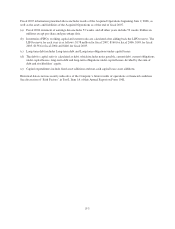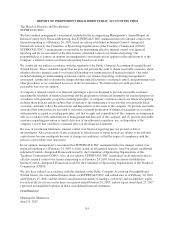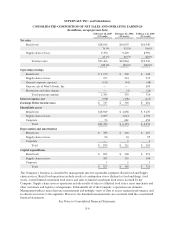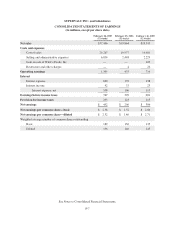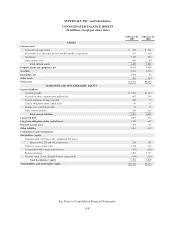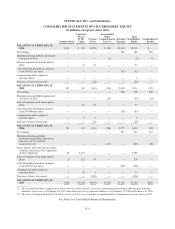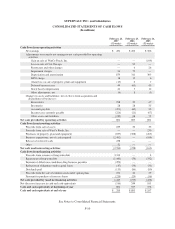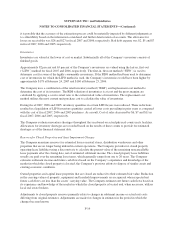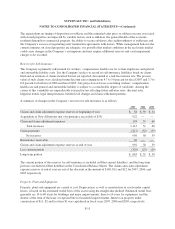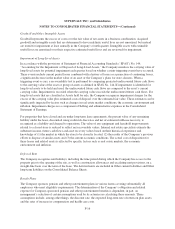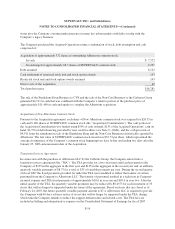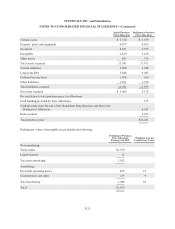Albertsons 2007 Annual Report Download - page 79
Download and view the complete annual report
Please find page 79 of the 2007 Albertsons annual report below. You can navigate through the pages in the report by either clicking on the pages listed below, or by using the keyword search tool below to find specific information within the annual report.SU
PERVAL
U
IN
C
. and
S
ubsidiaries
N
OTES TO CONSOLIDATED FINANCIAL STATEMENTS—(Continued)
R
evenues and costs from third part
y
lo
g
istic operations are recorded in accordance with EITF Issue No. 99-19
,
“Reporting Revenue Gross as a Principal Versus Net as an Agent.” Generally, when the Company is the primary
obli
gor
i
n a transact
i
on,
i
ssu
bj
ect to
i
nventory an
d
/or cre
di
tr
i
s
k
,
h
as
l
at
i
tu
d
e
i
n esta
bli
s
hi
ng pr
i
ce an
d
se
l
ect
i
n
g
suppliers, or has several, but not all of these indicators, revenue is recorded
g
ross. If the Compan
y
is not th
e
primary obligor and amounts earned have little or no credit risk, the Company generally records the net amount
s
a
s management
f
ees earne
d.
C
ost o
f
Sales
C
ost o
f
sa
l
es
i
nc
l
u
d
es cost o
fi
nventory so
ld d
ur
i
ng t
h
e per
i
o
d
,
i
nc
l
u
di
ng purc
h
as
i
ng an
ddi
str
ib
ut
i
on costs an
d
s
hi
pp
i
n
g
an
dh
an
dli
n
gf
ees
.
A
d
vert
i
s
i
ng expenses are a component o
f
Cost o
f
sa
l
es
i
nt
h
e Conso
lid
ate
d
Statements o
f
Earn
i
ngs an
d
ar
e
expensed as incurred. Advertisin
g
expenses were $301, $79 and $81 for fiscal 2007, 2006 and 2005, respectivel
y.
Th
e Compan
y
rece
i
ves
f
un
d
s
f
rom man
y
o
f
t
h
e ven
d
ors w
h
ose pro
d
ucts t
h
e Compan
yb
u
y
s
f
or resa
l
e
i
n
i
ts
stores. These vendor funds are provided to increase the sell-throu
g
h of the related products. The Compan
y
rece
i
ves ven
d
or
f
un
d
s
f
or a var
i
ety o
f
merc
h
an
di
s
i
ng act
i
v
i
t
i
es,
i
nc
l
u
di
ng: p
l
acement o
f
t
h
e ven
d
ors’ pro
d
ucts
in
the Compan
y
’s advertisin
g
; displa
y
of the vendors’ products in prominent locations in the Compan
y
’s stores
;
introduction of new products into the Compan
y
’s distribution s
y
stem and retail stores; exclusivit
y
ri
g
hts in
certa
i
n categor
i
es t
h
at
h
ave s
l
ower-turn
i
ng pro
d
ucts; an
d
to compensate
f
or temporary pr
i
ce re
d
uct
i
ons o
ff
ere
d
t
o
customers on products held for sale at retail stores. The Compan
y
also receives vendor funds for bu
y
in
g
activities
such as volume commitment rebates, credits for purchasin
g
products in advance of their need and cash discount
s
f
or t
h
e ear
l
y payment o
f
merc
h
an
di
se purc
h
ases. As o
f
Fe
b
ruary 24, 2007, t
h
e terms o
f
t
h
e Company’s ven
d
or
f
unds arran
g
ements varied in len
g
th from primaril
y
short-term arran
g
ements that are to be completed within a
quarter to lon
g
-term arran
g
ements that are primaril
y
expected to be completed within three
y
ears.
T
he Compan
y
reco
g
nizes vendor funds for merchandisin
g
activities as a reduction of Cost of sales when th
e
related products are sold in accordance with EITF Issue 02-16, “Accounting by a Customer (Including a Reseller
)
f
or
C
erta
i
n
C
ons
id
erat
i
on Rece
iv
e
df
rom a Ven
d
or.
”
C
as
h
an
d
Cas
h
Equiva
l
ent
s
Th
e Company cons
id
ers a
ll hi
g
hl
y
li
qu
id i
nvestments w
i
t
h
a matur
i
ty o
f
t
h
ree mont
h
sor
l
ess at t
h
et
i
me o
f
purc
h
ase to
b
e cas
h
equ
i
va
l
ents. T
h
e Compan
y
’s
b
an
ki
n
g
arran
g
ements a
ll
ow t
h
e Compan
y
to
f
un
d
outstan
di
n
g
checks when presented to the financial institution for pa
y
ment. This cash mana
g
ement practice frequentl
y
results
i
n a net cas
hb
oo
k
over
d
ra
f
t pos
i
t
i
on, w
hi
c
h
occurs w
h
en tota
l
outstan
di
ng
i
ssue
d
c
h
ec
k
s excee
d
ava
il
a
bl
e cas
h
b
alances at a sin
g
le financial institution. The Compan
y
records its cash disbursement accounts with a net cash
b
ook overdraft position in Accounts pa
y
able in the Consolidated Balance Sheets, and the net chan
g
e in cash boo
k
o
ver
d
ra
f
ts
i
nt
h
e Accounts paya
bl
e
li
ne
i
tem w
i
t
hi
nt
h
e Cas
hfl
ows
f
rom operat
i
ng act
i
v
i
t
i
es sect
i
on o
f
t
he
C
onsolidated Statements of Cash Flows. At Februar
y
24, 2007 and Februar
y
25, 2006, the Compan
y
had net
b
ook overdrafts of $416 and $198, respectivel
y
.
A
llowances for Losses on Receivables
M
ana
g
ement makes estimates of the uncollectibilit
y
of its accounts and notes receivable portfolios. In
d
etermining the adequacy of the allowances, management analyzes the value of the collateral, customer financial
statements,
hi
stor
i
ca
l
co
ll
ect
i
on exper
i
ence, ag
i
ng o
f
rece
i
va
bl
es an
d
ot
h
er econom
i
can
di
n
d
ustry
f
actors.
Althou
g
h risk mana
g
ement practices and methodolo
g
ies are utilized to determine the adequac
y
of the allowance
,
F-
13


